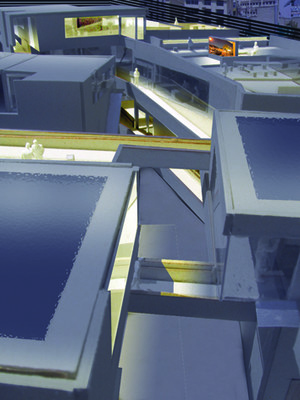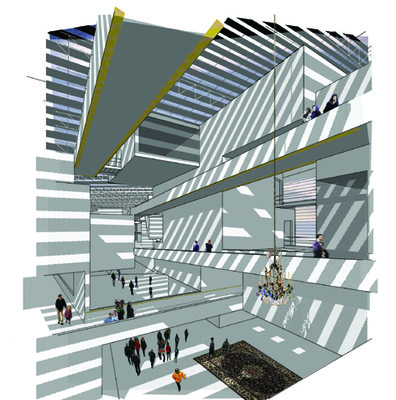The theme of the project is to design an Embassy for a United Europe. An embassy represents the national identity of a state in very different locations and nations. Therefore my approach has been to first develop a prototype as a basis for the designs of European Embassies all over the world. The developed prototype is then implanted in a chosen location – thus national context – considering the architectural peculiarities and the climate of the chosen country.
Since the diplomatic relevance of the Middle Eastern countries has permanently increased after the end of the Cold War the location I have chosen for my design is Teheran/Iran.
The building has been developed in several layers. The first two layers of the prototype deal with the questions of what the European embassy is today, and will be like in the future.
Layers 3 to 5 deal with the peculiarities and archetypes found in Iran and how they can be reused in the context of a European Embassy.
The Prototype:
Layer 1: Europe
My future vision of Europe is a United Europe as one state with a common foreign policy, which is thus represented abroad via one common embassy. Next to this unity there will be a federal system with a diversity of sub-states, people and languages.
Both should be represented in the European Embassy.
Layer 2: The Embassy
The most interesting element of an embassy in this project is its internal border. It separates the diplomatic from the public program. This border is very strict. People entering the limited public part never come in touch with the diplomatic part and vice versa. Since transparency is essential in democratic political systems, it should also be an issue in the European Embassy: the embassy should be as transparent as possible. The ambassador should be “in touch” with the people queuing up for a European visa; people visiting the embassy should get an idea of how an embassy works. In place of a strict border, a dialogue between the diplomatic and the public level of the embassy should be reached
To achieve this I decided to organize the public and the diplomatic program linearly along two paths which both lead through the whole building. The paths – and the program attached to them – can approach each other or diverge. This ever-changing relation between the two paths expresses the internal border: it ranges from highly transparent to totally closed.
Today a globalization of former national problems is taking place. Foreign affairs are to meet and find a solution for these common problems. The embassy should widen this communication from a pure political level to a dialogue between societies. It should widen its public program and become a place of cultural interaction. As a piece of Europe in any cultural and political context, it should provide spaces for open discussions, lectures and art.
The Building in its National Context:
Within the architectural peculiarities of Iran there are four elements that strike me most: the introverted patio houses with their prosperous inner life, the linear organization of the bazaars, the play of light and shadow and the climatic schemes of the ancient desert architecture. Each of them can be found back in the building and has become a specific layer in my scheme.
The building mainly consists of three elements:
– Volumes as the load-bearing elements, which host the different programs.
– Two paths – a public and a private one – which run along the volumes and solve all height differences within the building.
– A facade, which unifies the inner diversity.
Layer 3: The Introverted Patio Houses
The ancient Iranian patio houses provide a wide range of public and private spaces. The inner courtyard provides a cool and comfortable climate in the summer and is therefore the social center of the house. Here the family meets and the guests are welcomed. It is the most public place in the house. This “public” void is created by the private rooms, which surround it. This leads to an inverse scheme: the inner courtyard as the social center of the family is separated and protected from the public street life by the most private spaces of the house, the sleeping rooms.
The same scheme is translated in my design for a European Embassy in Teheran:
The main part of the program is placed within the volumes. The volumes are arranged next to each other as a continuous landscape forming two patios at the far ends of the building. The public foyer is placed in the front patio – the center of social life – and the diplomatic foyer is placed in the back patio. Both patios are traversed following either the diplomatic or the public path, allowing a visual dialogue between public and private.
Layer 4: The Linear Organization of the Bazaars:
In most of the ancient Iranian cities the bazaar functioned as the main city structure. It is the place where the social and economic life took place. It is a system of paths directly attached to shops in which vendors offer their products. Here the border between the public path and the private shops blurs. Next to the shops, the main institutions of political and religious life are also attached to the paths. In this case there is a threshold between public path and private institution (i.e. an iwan with a corridor which leading from the bazaar to a mosque).
This differentiation can be found back in my design for a European Embassy in Teheran:
The two paths in the building form a double helix giving access to the different programs. The public program is directly attached to the paths whereas the private program is indirectly attached via thresholds. These thresholds are, for example, little bridges between path and volume or a slight difference in floor level.
Layer 5: The Play of Light and Shadow and the Climatic Schemes of the Ancient Desert Architecture:
The contrasting play of shadow and light performs a major role in traditional Iranian architecture. The bright sun and heat don’t allow open facades unless a big roof can provide enough shadow. Therefore openings are kept quite small, letting the bright sunlight appear as a spotlight inside the building. As in all countries the climate has a strong influence on the rhythm of public life. During summer the streets are populated in the early morning and evening hours rather than in the middle of the day.
The play of light and shadow is part of my design of the European Embassy in Teheran:
The building has a facade of two layers regulating the climate and the incidence of light within the building. The outer facade consists of movable slate lamellae. On the roof the slate lamellae are replaced by solar lamellae, which make the building independent from external energy support. Depending on time and season, the lamella-skin closes or opens: the building begins to “live.” It follows the rhythm of public life.
The concept of the double helix can only work if the two paths cross visually but not physically. Therefore the building has two entrances:
–The public entrance is placed on street level on the east side of the building. The hill on which the building is placed recedes to create a generous, open public entrance. The entrance area functions as a public “park.” People can rest here or wait in the shadow of the trees for the sun to set.
–The diplomatic entrance is placed on the west side of the building. By following the topography of the hill it enters the building on the first floor. In contrast to the public entrance the diplomatic entrance is kept closed and is only accessible for the diplomats and their staff.
The Material:
The two paths also differ in the material used for their applications. For the diplomatic path dark cherry wood is used in order to create a sublime atmosphere. For the public path light birch wood is used, which creates open and friendly surroundings. This scheme of materials is also valid for the different programs of the embassy: dark cherry wood stands for a diplomatic program, light birch wood for a public program, and chrome for a program which is used and accessible from both paths.
Outlook:
The prototype of the European Embassy (the concept of the two paths) can be used as a tool to design all the other European Embassies in any of the other 171 countries of the world. In combination with the peculiarities which will be found in these countries, it will lead to individual but nevertheless recognizable designs.
Lisa Hassanzadeh is a German/Iranian architect living and working in Amsterdam.

